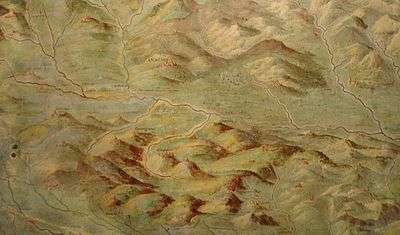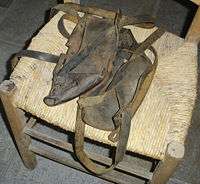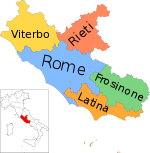Ciociaria
Ciociaria (Italian pronunciation: [tʃotʃaˈriːa]) is an area of Central Italy roughly corresponding to the province of Frosinone, Lazio, but without a defined border nor historical identity.[1] The name was adopted by a fascist movement of Frosinone as an ethnic denomination for the province of Frosinone, when it was created in 1927, following the dissolution of the province of Terra di Lavoro (in Campania), of which the area was historicaly part.[2] In the Middle Ages, this region was referred to as Campagna. The local dialect, now known as ciociaro, was earlier referred to as campanino. In more recent times, the term Campagna Romana, or Roman Campagna, a favorite subject of countless painters from all over Europe, has referred to the adjoining region to the north of Ciociaria, but part of the Province of Rome.


Origin of the name
The term first appears in a map of the Papal States, in which a land in Campagna e Marittima province is named Ciocciarìa.[3] The variant Cioceria has been used since the 18th century.[4][5]
The name Ciociaria comes from the primitive footwear of its inhabitants, ciocie. These shoes are rarely used nowadays, but remain as a local symbol, used by folklore groups, and for historical celebrations.
Folklore and traditions

Ciociaria has annual food fairs, entertainment events and music festivals, as well as a variety of traditional feasts. Religious, country and rural traditions are still strong and alive. There are also celebrations of the patron saints with their processions, performances of bands, singers and groups, illuminations and fireworks, fairs and popular games, and palios and tournaments among the town’s quarters.
During popular events people wear traditional costumes with the typical footwear, the ‘cioce’, which gave the name to this region “Ciociaria”. Part of the Ciociarian folklore are the songs, both sacred and profane, dances such as the saltarello, accompanied by music and the dishes of local cuisine.

Handicraft
The Symbol of Ciociara is a copper amphora called "Conca", formerly used to carry water from the fountains; such containers are still made by local artisans. Wicker and “vinchio” (marshy grass that grows on the slopes of the Aurunci Mounts) are woven in the shape of baskets, hampers, bags and cheese or fish containers. Terracottas are also made: from water amphorae, the so-called “cannate”, decorated with red soil as well as pottery articles decorated and enamelled (like little bells and crib statuettes) made in Arpino, to terracotta jugs made in Aquino and Fiuggi.
Gold and coral jewellery have always been worn by the famous “balie ciociare” (Ciociarian wetnurses). The main producing towns are Alatri, Anagni, Fiuggi, Veroli. Works in copper and wrought iron can be found in Ferentino, Serrone and Frosinone; in Veroli there is an “Exhibition of Wrought-Iron” held every two years. The travertine of Anagni is extracted from local quarries. There are embroideries, like the embroidered towels and tablecloths of Veroli and Boville Ernica and the holy vestments of Anagni, “the Town of Popes”.
Rapes after the battle of Monte Cassino
The day following the Battle of Monte Cassino, Goumiers rampaged through the surrounding countryside committing mass rape in Ciociaria.[6] Victims of such crimes became known in Italy as marocchinate, literally translatable as "Moroccaned". Alberto Moravia wrote a novel on the event (La ciociara), which was made into a successful movie directed by Vittorio de Sica, and an opera by Marco Tutino.[7]
See also
References
- Roberto Almagià, Enciclopedia italiana, vol. X, Roma 1931
- Alonzi L., Il concetto di Ciociaria dalla costutuzione della provincia di Frosinone a oggi («L'Italia ritagliata. L'identità storico-culturale delle regioni: il caso del Lazio meridionale ed orientale», Società Geografica Italiana, Roma 1997)
- Beranger E. M. & Sigismondi F., Il ducato di Alvito nell'Età dei Gallio (Atti), Banca della Ciociaria, Alvito 1997, p. 37
- Scotoni L., Un nome territoriale recente: la Ciociaria (Lazio), in La geografia delle scuole, XXII (1977), n. 4., pp. 199-207
- The term "Cioceria" as found in books.google.com Accessed 9 December 2017
- George Duncan's "Massacres and Atrocities of World War II" at members.iinet.net.au Archived 2016-03-03 at the Wayback Machine Accessed 9 December 2017
- Two Women (La Ciociara) - premiered at San Francisco Opera - Composer: Marco Tutino Accessed 9 December 2017
External links
![]()
- CiociariaTurismo, official tourist site of Ciociaria
- Keepers of a dying dialect: Italian immigrants in Sarnia, Ontario, still speak an ancient language
